 If you would like to serve a fairly easy, do ahead, with only a small amount of last minute putting together, first course to a meal, may I suggest grilled goat's cheese salad?
If you would like to serve a fairly easy, do ahead, with only a small amount of last minute putting together, first course to a meal, may I suggest grilled goat's cheese salad?
if
 Quail's eggs seem so elegant. Small, yet perfectly formed and presented in a beautiful package. I have wanted to serve lightly hard boiled quail's eggs as finger food before a special meal for some time. So I finally did!
Quail's eggs seem so elegant. Small, yet perfectly formed and presented in a beautiful package. I have wanted to serve lightly hard boiled quail's eggs as finger food before a special meal for some time. So I finally did!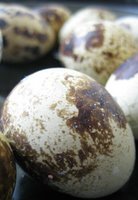 They were simple : simple to cook and simple to serve. But they were slightly tricky to peel and eat. I think that perhaps they are more conducive to sitting around, perhaps outside, killing time with friends, wine and food, rather than as predinner nibbles. You need somewhere to put your glass while you are peeling and somewhere to put the shell before dipping. I know I could have peeled them, but then the beautiful shells would have been lost. However, I am dying to make mini-scotch eggs with them soon!
They were simple : simple to cook and simple to serve. But they were slightly tricky to peel and eat. I think that perhaps they are more conducive to sitting around, perhaps outside, killing time with friends, wine and food, rather than as predinner nibbles. You need somewhere to put your glass while you are peeling and somewhere to put the shell before dipping. I know I could have peeled them, but then the beautiful shells would have been lost. However, I am dying to make mini-scotch eggs with them soon!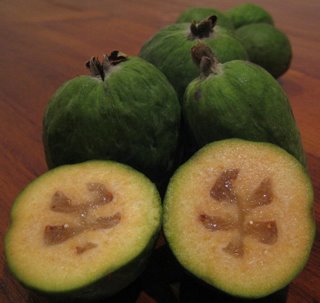 Sadly, the feijoa season is all but over. My favourite fruit. Something of which I have a hard time enjoying just one, I always think a pile of them do the wonderful flavour more justice.
Sadly, the feijoa season is all but over. My favourite fruit. Something of which I have a hard time enjoying just one, I always think a pile of them do the wonderful flavour more justice.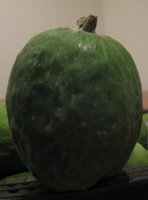 My mother makes feijoa chutney, several people I know make feijoa jam, stewed feijoas feature in pies and sauces, and a friend of mine is about to bottle his home made feijoa cider. But the only thing I can ever bring myself to do with this fruit is to eat them raw, by themselves, scooping the flesh from the skin of each half with a spoon. So delicious.
My mother makes feijoa chutney, several people I know make feijoa jam, stewed feijoas feature in pies and sauces, and a friend of mine is about to bottle his home made feijoa cider. But the only thing I can ever bring myself to do with this fruit is to eat them raw, by themselves, scooping the flesh from the skin of each half with a spoon. So delicious.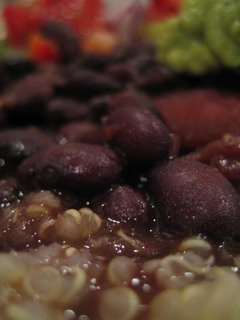 This was not what I had planned for the Fabulous Favorites Festival but it came together as a fabulous favourite nonetheless! I was planning to describe a fantastic salmon feast with a specially chosen bottle of de Lapeyre Jurancon Sec, but when the happy accident described below came together it seemed more fitting.
This was not what I had planned for the Fabulous Favorites Festival but it came together as a fabulous favourite nonetheless! I was planning to describe a fantastic salmon feast with a specially chosen bottle of de Lapeyre Jurancon Sec, but when the happy accident described below came together it seemed more fitting. So imagine my pleasure when I decided to pick a bottle of wine to accompany the black bean chilli and came up with a winner. A wine that accentuated the hotness of the chilli (sweet), kept up with the flavours in the chilli and guacamole (had a definite character), yet slightly acidic that went beautifully with the fatness of the guacamole and the sour cream.
So imagine my pleasure when I decided to pick a bottle of wine to accompany the black bean chilli and came up with a winner. A wine that accentuated the hotness of the chilli (sweet), kept up with the flavours in the chilli and guacamole (had a definite character), yet slightly acidic that went beautifully with the fatness of the guacamole and the sour cream.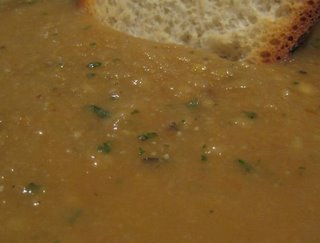 It is getting cold here now. The last couple of days have certainly been wintery. Just the weather for a lovely, thick and wonderfully tasty soup. Soup to put in a bowl to wrap your hands around. Makes winter something to welcome.
It is getting cold here now. The last couple of days have certainly been wintery. Just the weather for a lovely, thick and wonderfully tasty soup. Soup to put in a bowl to wrap your hands around. Makes winter something to welcome.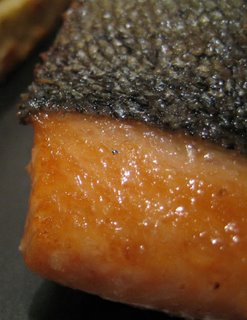 My friend Helen, who lives in Twizel, made my day on Wednesday when she called to tell me that some salmon would be winging its way to me in Wellington that evening. This salmon was so fresh that at the time Helen called me the fish would have still been swimming.
My friend Helen, who lives in Twizel, made my day on Wednesday when she called to tell me that some salmon would be winging its way to me in Wellington that evening. This salmon was so fresh that at the time Helen called me the fish would have still been swimming.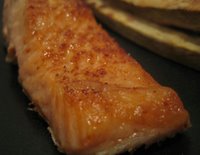 Then the main course - my favourite way to prepare salmon. Oven seared. Lightly seasoned, and cooked hot and quick. No mucking around.
Then the main course - my favourite way to prepare salmon. Oven seared. Lightly seasoned, and cooked hot and quick. No mucking around.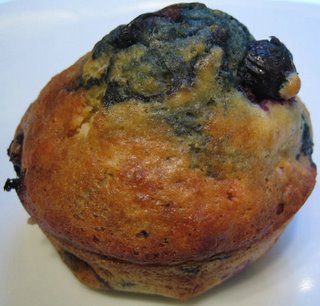 Of all the muffin flavours, blueberry has to be the classic. Cake-like, certainly, but not cake. The tartness of the blueberries offset the sugar in the batter.
Of all the muffin flavours, blueberry has to be the classic. Cake-like, certainly, but not cake. The tartness of the blueberries offset the sugar in the batter. thday in January with the promise that it would fruit twice a year - once around Easter and once toward the end of the year. Well, what-do-you-know, it did fruit around Easter and last weekend we picked the blueberries. This lovely bush/tree gave us 8 blueberries for its first fruiting - isn't that marvelous!?
thday in January with the promise that it would fruit twice a year - once around Easter and once toward the end of the year. Well, what-do-you-know, it did fruit around Easter and last weekend we picked the blueberries. This lovely bush/tree gave us 8 blueberries for its first fruiting - isn't that marvelous!? I have been looking forward to the next installment of Paper Chef and I was very pleased when Kevin of Seriously Good announced the 17th edition of the ever popular online event Paper Chef.
I have been looking forward to the next installment of Paper Chef and I was very pleased when Kevin of Seriously Good announced the 17th edition of the ever popular online event Paper Chef.
 This is a very special recipe to me. Not because it is ground breakingly new, very clever or difficult. It is special because I feel like the mother of this dish. I had a hand in [almost] each component. Might sound silly, but all of you who have started on the continuum of gardening, stepped on the path of bread-making, entered into the world of bacterial fermentation, you will understand.
This is a very special recipe to me. Not because it is ground breakingly new, very clever or difficult. It is special because I feel like the mother of this dish. I had a hand in [almost] each component. Might sound silly, but all of you who have started on the continuum of gardening, stepped on the path of bread-making, entered into the world of bacterial fermentation, you will understand.
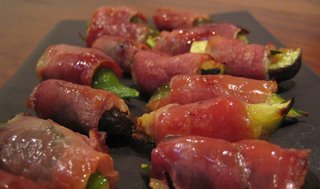 Finger food - oh yes, I do like finger food. Something that is easy to eat while doing at least two other things - drinking and talking, and at times, listening too.
Finger food - oh yes, I do like finger food. Something that is easy to eat while doing at least two other things - drinking and talking, and at times, listening too.  When you have saved your pennies and bought a free range organic, slowly and naturally reared, and properly raised chicken you will want to use every bit of the treat that a chicken has once more become.
When you have saved your pennies and bought a free range organic, slowly and naturally reared, and properly raised chicken you will want to use every bit of the treat that a chicken has once more become.